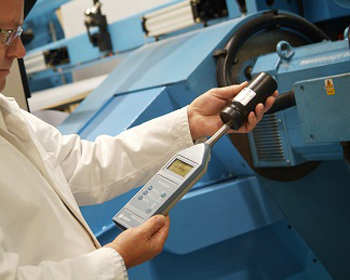Looking To Comply With The Noise At Work Regulations
Pulsar Can Help

Noise measurement products can help you reduce the risk of damage to the hearing of your employees from exposure to noise.
If you operate a noisy workplace and are not sure whether the noise levels are within the current Noise Regulations, the safest way to establish whether you comply with the law is to measure noise.
You can, of course, undertake a few simple tests to start with to check whether there is a risk. For example, if you need to shout at 2 metres from somebody to make yourself heard or experience stress when noise starts or relief when it stops, the noise levels are likely to be at or above 85dB(A). This is around or above the recommended level for action and means that the noise is potentially harmful to hearing.
It is not recommended to rely just on these rules or the human ear alone because of the effects of Temporary Threshold Shift. Rather, accurate measurements of noise at work by a competent person with a compliant professional sound level meter is recommended in this case.
Measure noise at work with a professional sound level meter.
A sound level meter is a hand held instrument used by safety professionals to measure sound pressure level, commonly used in occupational noise surveys for the quantification of different kinds of noise. Pulsar Instruments offer a full range of professional sound level meters, from the simplest point and shoot noise meters to the more advanced models and their associated reporting software.
Field calibration
Field calibration is a requirement for most occupational and environmental noise monitoring legislation. Noise monitoring equipment such as a sound level meter or personal noise dosimeters should be calibrated prior and after each measurement session.
Calibration should be carried out using a suitable acoustic calibrator that fits perfectly over sound level meter’s microphone capsule. It is important to remember that this capsule is the most fragile, important and expensive part of your instrument. It can become damaged through accidental misuse and give inaccurate measurements. By using an acoustic calibrator, the meter is typically less than + or – 0.1dB out. This ensures accuracy of your measurements.
A Windshield
A windshield is an important accessory for your noise measurement device. It reduces the influence of wind during outdoor monitoring. It protects your meter’s microphone capsule from moisture and from accidental knocks. It also helps protect the capsule from any chemicals that may be in the air. Finally, it prevents from workers who are being monitored from being 'poked' in the eye if they turn round towards you suddenly.
Carrying out measurements
When using a sound level meter, point it at the worker’s ear(s), 100mm from ear or at the level where the operative’s head would normally be. When measuring machine noise, place yourself 1m from the machine and at a height of 1.5m. When measuring area noise levels, position yourself in gangways etc. to assess the risk to office staff, maintenance staff and visitors.
Good practice
It is good practice to talk to workers to establish typical working practices and activities together with the allocated durations for each activity. Take notes also regarding each working position and which ear is measured. Allow enough time to get a representative measurement. Write down the LAeq and ‘C’ weighted Peak figures displayed on your sound level meter. Finally, use the higher value of right and left ear measurement and round up to the nearest decibel.
How loud is too loud?
Excessive long term exposure to noise can lead to permanent damage to a person's hearing. It is important to remember that the risk and amount of damage that can be caused depends on the level of noise and the duration that the person is exposed to the noise.
For information on noise measurement technology such as sound level meters or personal noise exposure meters to help gathering noise data at work and complement any risk assessments to achieve compliance with the Noise at Work Regulations, consult our website.
CONTACT
Pascale O'Rourke
Pulsar Instruments Plc
pascale.orourke@pulsarinstruments.com
www.pulsarinstruments.com
+44 (0) 1723 518011
Friday 3 July 2015 / file under Engineering | Safety



